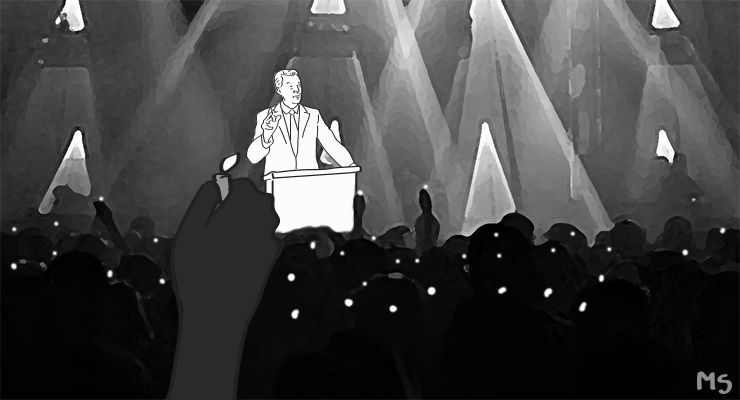
Traditionally, the Christmas–New Year’s break is a politically dead time, slowly snoozing its way from the prime ministerial pre-Xmas message until our leaders reappear alongside our men’s cricket team sometime during Sydney’s New Year’s Test.
This year, however, at Woodford Festival — an annual arts and music event — Arts Minister Tony Burke used a break between sets to offer pointers about what we should expect from the government’s proposed cultural policy, set for release on January 30.
It looks like Labor has crunched the numbers: festivals are delivering crowds too big to ignore, with Woodford goers getting an early peek at how Labor hopes to drive a national culture shift: by hurrying the country on from second-rate replays of US culture wars to an arts industry grounded in Australian stories, driven by Australian creators.
Australia’s conservatives and their supporting media snub their noses at culture policy, shaking it off as a preoccupation of latte-sipping, inner-city elites.
Labor seems to be reading public interest differently. It’s making culture policy a first-year priority for the government. Sure, Labor is familiar with cultural policies, such as Keating’s Creative Nation in 1994 and Gillard/Rudd’s Creative Australia in 2013. (Disclosure: I was part of then arts minister Simon Crean’s Creative Australia working party.)
The difference? These were last-term initiatives, each quickly killed off by the incoming conservatives. Instead, the Abbott-Morrison era embrace of US culture wars drove a growing misalignment between where Australia — and Australians — found themselves politically and how they thought culturally. This time around Labor seems keen to move quickly to close the gap.
Burke’s Woodford comments are more directional than definitive, with more details to come in the end-of-month announcement — and big funding decisions for cultural institutions, such as the National Library’s Trove archive, put off to the May budget. The two significant policy commitments — Australian content quotas for streaming services to fund more Australian productions and the extension of lending payments to e-books — came without numbers attached.
But the direction matters. Burke’s approach looks to creative workers, hoping to pump supply to meet the unsatisfied demand for Australian stories. He wants, he says, “to make sure we are looking at the artist as a worker … artists have often been training from the age of children all the way through, working on their craft. They have a right to fair remuneration, and they have a right to safe workplaces.”
He foreshadowed a “re-gearing” of the Australia Council to shift from a funding-centric body to a more sophisticated policy and development institution with a renewed commitment to the Whitlam-initiated peer-funding model.
He stressed the opening phrase of the five policy pillars announced last July — “First Nations first” — talking up greater cultural-self determination through training in technical skills across all aspects of creative production, a direct Indigenous say over institutional collections and, importantly, through financial control of their works as they evolve. (The Productivity Commission looked at what this could mean for Indigenous visual artists in December.)
Burke said: “I want to be able to change the financial power relationship so that if a work is growing, it grows in the way that the First Nations artist has not simply self-determination of what they wrote, but self-determination over the finished work.”
Burke’s use of the festival stage was a medium-is-the-message moment that demonstrated the growing power of the festival circuit as a political forum. It followed on from Albanese’s use of the Garma Festival in August to announce the draft question for the Voice to Parliament referendum, as well as his own Woodford appearance with Indigenous Australians Minister Linda Burney to position the cultural centrality of the referendum — “it will … enhance both the way Australians see ourselves, and the way we are seen by the world” — as he confirmed the vote would be held sometime this year.
For the time being, Labor has the stage (and the 125,000-odd audience) to itself. The conservatives are reluctant to follow Labor’s lead: “sandal makers and basket weavers”, sniffed the LNP’s 1980s-style, would-be bovver-boy-in-chief Matt Canavan.
It’s tricky ground, too, for Australia’s political media, struggling to understand yet another shift in the political cycle. Back in April, Albanese rebooted his election campaign, with a guest slot at the Byron Bay Blues Fest: “Rock star reception,” said an early take in the Nine papers, before Sky News’ insistence on “boos and jeers” hurried the traditional media onto the safer ground of “mixed reception”.
This time around, the right-wing media have been trying again to pull the power of the festival appearances with a focus on a handful of Stop Adani protestors. But if Labor drives policy to close the gap between culture and politics, traditional media, too, will have to catch up.
What would you like to see in Labor’s cultural policy? Let us know by writing to letters@crikey.com.au. Please include your full name to be considered for publication. We reserve the right to edit for length and clarity.








I was greatly encouraged to see that Prime Minister Albanese and Ministers Linda Burney and Tony Burke all attended the Woodford Festival.
The consequences of the medium being the message are enormous, and not well understood. And yet, it can be summarised in less than 240 characters:
TV news is misleading because of what it leaves out: Historical context. For that, you have to read books.
Could festivals really be the next big medium for news and current affairs? If that happens, what would it mean?
Firstly, if music is any guide, yes, festivals could be the next big medium. Streaming forced artists to learn how to earn revenue from live appearances, because since Napster, few recording artists have been able to make much money from recordings. And so they do. Musical professionals now earn most of their income from concerts and merch. The same thing could happen for news and current affairs.
How might this work?
The limitation of television is that news items are only 30 – 120 seconds long. That’s not enough time to provide historical context. And because most TV news is paid for by advertising, the goal of producers is to grab attention in order to earn the most ad revenue. So TV news is sensationalism. It’s about a 10 second grab of a knockout punch, not the long explanation required to contextualise the punch or the invasion or the ripoff or the impact on victims.
Festivals could change that. Speakers get an hour, not 30 seconds.
An hour is still not enough. It might take 6 hours of reading to get start on understanding Russia, or Indonesia, or Nuclear power, or the petroleum industry, or cancer.
But in an hour of face to face communications, a speaker can recommend books in a compelling way, because the audience can hear their voice and see their eyes and hands. In an hour, a good speaker can inspire an audience to go away and read books.
What might that lead to?
Resurrect 10AB?
We’re swamped with USA culture, even the ABC news which has a grid iron player collapsing on high rotation, even interviews with his doctor. I wish the bloke well, but is it really the most important news for Australians?
That followed non-stop coverage of snow storms in NE USA. Of interest, but do we really need live crosses to every passer by?
The presenters love American accents, hurri-cane, dee-cide, oh-fence. It’s even got, sorry gotten, some presenters with real American accents for credibility.
Don’t know if if it’s cheap and easily sourced material, or the awe in which USA media is held. It doesn’t seem to be getting better, not now, not anytime soon.
Sorry dudes, that should have been ‘not right now’. Must have had my baseball cap facing forwards.